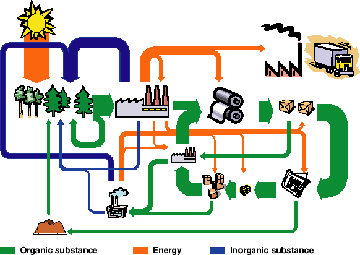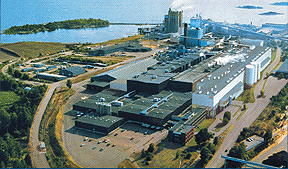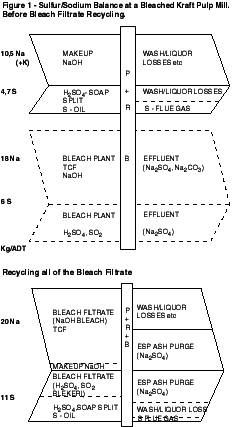|
Bleached kraft pulp mills have made great progress in reducing pollutants, but there is some way to go before they are truly minimum effluent mills
By Björn Warnqvist
Closing in on the bleached kraft pulp mills
As the millennium draws to a close, the vision of the forest products industry as an ecocyclic industry is becoming firmly established in the minds of many people. This vision involves much more than simple environmental compliance - it is aimed at sustainable resource utilization, efficient internal conversion and recycling of fibers, chemicals and energy.
The large majority of companies are now taking steps toward implementing ecocyclic processes at their plants, but the concept also goes beyond the mill itself. The idea also encompasses the flow and delivery of recycled resources to other industries, society and markets (Figure 2).

The pulp and paper industry has taken great strides in this direction in recent years. Apart from the marked reductions in key pollutants such as SOx (sulfur oxides), NOx (nitrogen oxides), chlorinated organics, BOD (biochemical oxygen demand) and COD (chemical oxygen demand), it is also important to note that the industry's emissions of CO2 (carbon dioxide) per ton of product has dropped by almost 80-90% since the 1960s, at least in Scandinavia.
Ecocyclic visions and sustainable industrial production methods have also become the main focus of the high profile environmental policies formulated by many European and some North American companies. A quick glance at the web sites of SCA, Södra, Stora Enso, Weyerhaeuser and other companies confirms this trend.
Minimizing at the mill
At the mill level, ecocyclic principles require closed cycle compatible process technology. But this does not necessarily mean that mills are 'totally effluent-free' or TEF. Instead, the process could be considered as MEM (minimum effluent mill), MIM (minimum impact mill), or even 'minimum input mill' in view of the elemental input/output mass balance equation.
Trying out the MIM way at Stora Enso's Skoghall mill

As part of the concept, mills must learn to use their resources in an efficient way. This would involve using wood, water, chemical and energy resources to their maximum potential. Added to that, the process also involves minimizing effluents by internal measures, sometimes backed up with efficient external treatment. The mills may also sell and deliver their excess energy (and chemicals) to other industries or members of society.
Since the 1970s, process technology developments, particularly in Scandinavia, have resulted in more intra-mill (low loss) handling of fiber, water and chemicals. Some examples of this development are:
• oxygen delignification
• closed screening
• modified kraft cooking processes
• new pulp washing processes such as pressure diffusers, wash presses, etc
• dry barking
• TCF (totally chlorine-free) and ECF (elemental chlorine-free) bleaching
• odor and condensate handling/cleaning technology
• white and green liquor filtration.
As a result, delignification before bleaching for softwood pulp has been reduced from 30 kappa in the 1970s to just 10-12 kappa today. Added to that, some bleach effluents are now being recycled to recovery.
Balancing act
The operation of an MIM also requires short and long term control of the flow balances of all input, output and internal process streams. Non-process elements (NPEs) must also be controlled, to avoid accumulation and consequent process problems in a closed-cycle mill. Mills need to pay close attention to the following non-process elements:
• dead load in the liquor cycle and plugging of the recovery boiler caused by K (potassium) and Cl (chlorine)
• corrosion caused by Cl
• deposits in equipment caused by Al (aluminum), Si (silicon), Ca (calcium), Ba (barium)
• ballast in the lime cycle caused by P (phosphorus), Al, Si and Mg (magnesium)
• negative process and product quality effects in the oxygen and peroxide stages caused by Mn (manganese), Fe (iron), Cu (copper)
• the environmental impacts of N (nitrogen), P, Cd (cadmium), etc.
Wherever possible, the input flows of these elements from wood, water and chemicals must be minimized, or alternatively, controlled outputs need to be put in place. Some NPEs have natural points of removal in the kraft process though. For example, Mg and heavy metals are removed with dregs, ie through green liquor cleaning. Similarly, lime mud purge and grits can get rid of P, Al, and Si. In the cases of K and Cl, these tend to be enriched in electrostatic precipitator (ESP) ash, due to their process chemistry in the recovery boiler. As a result, some ESP ash can be purged to control K and Cl levels.
There are also more sophisticated methods available to recrystallize ESP ash and purge K and Cl salts as a residual water solution. One such example is the BFR-CRP - the bleach filtrate recycle-chloride removal process which is used at Champion's Canton mill in the USA. At the same mill, Champion is also getting rid of heavy metal ions by ion exchange using BFR-CRP. Cl can also be removed by a special ion exchange process called PDR that was developed by Paprican and Prosep/Eka.
Across the Atlantic, Södra is testing another process to remove metal ions at its Värö mill in Sweden. This process is based on controlled precipitation and flotation using the Netfloc technology developed by Kemira.
Unfortunately, most purges have one thing in common - they produce sludge. In future, mills will not be allowed to simply dump this sludge in a landfill due to the lack of landfill sites, public dumping fees and the sustainable closed cycle concept in general. Instead, mills will be required to find environmentally safe methods of handling and final disposal of sludge.
ESP ash could be disposed of safely in the sea, where billions of tons of K, Na and Cl salts are found naturally already. But if an economically viable way of electrolytically splitting ESP ash into caustic and sulfuric acid could be found, this would be the "ideal" closed-cycle solution.
Alternative disposal methods for dregs have also been studied. For example, dregs combined with hog fuel boiler ash have been tested for use as a forest fertilizer. This would be a logical solution as most of this inorganic material is typically found in wood anyway. In this process, some heavy metals, such as Cd, may require extra attention though, even if they are only present in trace amounts.
Sodium and sulfur
Another area that mills must keep an eye on in closed-cycle kraft mills is the overall flow balance of S (sulfur) and Na (sodium). If bleach filtrate is recycled to recovery - either directly or via oxygen stage and brown stock washing - the inorganic chemicals in the filtrate will more or less replace the normal makeup. Since the S/Na ratio, as well as the mass flows, of the bleach filtrate may well deviate from that of the liquor cycle, new chemical balance situations may emerge.
This situation can occur when mills recycle alkaline bleach filtrate with a low S/Na ratio. In order to reach the required chemical balance, mills must either reduce S emissions to the air or increase the pure S makeup. Added to that, the mills can also remove ESP ash or purge a sulfur-free process stream, for example, the soda from green liquor. In the case of recycling both acid and alkaline bleach filtrate, mills need to purge ESP ash in order to redress the chemical balance.
Figure 1 indicates the flow balance of S and Na in an existing bleached kraft pulp mill, before bleach plant filtrate is recycled and after all bleach filtrate (alkaline and acidic) is recycled. The latter case is a model calculation as the mill in question is only recycling part of its bleach effluent at present. Clearly, the overall balance, including the bleach plant and the effluent of inorganic S/Na chemicals, is only changed marginally. But it must also be remembered that bleaching chemicals are used to replace the makeup.

Of course, bleach filtrate recycling is not only carried out to save makeup chemicals, but also to incinerate the bleach organics (COD) in the recovery boiler. In this mill, the total COD content of the bleach plant effluent amounted to 25 kg/ADT (air dried tons) out of a total effluent of about 45 kg/ADT.
A number of Swedish bleached kraft pulp mills already recycle bleach effluent/filtrates (mainly alkaline) on a continuous basis or at specific times. These include MoDo's TCF sulfite pulp mill at Domsjö and the company's Husum mill, which produces ECF birch pulp. Other companies trying out the process at TCF mills include SCA at its Östrand pulp unit, Munksjö's Aspa mill and Södra's Värö pulp mill. On the ECF side, Stora Enso's Skoghall mill and Korsnäs' pulp unit are also recycling alkaline bleach filtrate in this way.
Most of the mills encountered initial operating problems, particularly with deposits of calcium oxalate in process equipment. For example, deposits commonly turned up in the wash filters in the bleach plant. In general, this process has limited the reduction of the bleach plant's external effluent flow to the range of 5-10 m/ADT so far.
At the ECF mills, the process can also reduce Cl (chloride) levels. The Cl content in alkaline filtrates can be minimized in theory by efficient inter-stage washing in the bleach plant. In Swedish mills, a typical maximum target level would be approximately 2-3 g/l Cl (in white liquor). Below this level, problems with sticky deposits and plugging can generally be avoided in existing recovery boilers (superheater, generating bank). In Canada though, there are examples of recovery boilers designed for high Cl levels that can tolerate 5-10 g/l Cl in white liquor.
On the integrated side, there are also a number of kraft pulp mills using this process. At these mills, a modest percentage of TCF pulp is produced, ie 10-40 % of total capacity. Swedish mills that fall into this category are paperboard and liner mills such as AssiDomän's Frövi mill, SCA's Munksund and AssiDomän Kraftliner. At these mills all bleach filtrate (from a short sequence TCF bleach plant) is recycled to recovery.
Alkaline filtrate is recycled counter-currently within the "bleached" pulping line and acidic (Q-stage) filtrate is taken to the unbleached pulp line (wash plant). At AssiDomän's Frövi mill, acidic filtrate is recycled via black liquor evaporation. To control the mill's sulfur balance, AssiDomän Kraftliner has also installed an on-site sulfuric acid plant mainly fed by the strong sulfur gases obtained in the mill's odor control system.
In general, experience as well as theory shows that employing efficient wash equipment is crucial if a mill wants to achieve sustained bleach plant closure and filtrate recycling. This would include modern wash presses, displacement washers or pressure diffusers. This type of equipment ensures high dissolved solids recovery, minimum filtrate volume and minimum fiber content in the filtrate. Mills also need to pay attention to pH and metal ion management to avoid calcium oxalate scaling and control bleaching chemical (particularly peroxide) consumption.
Clean future
In Sweden, the main driving force behind the introduction of MIM or MEM mills comes from the Swedish environmental protection agency, the Naturvårdsverket. The organization is calling for effluent COD targets of 10-15 kg/ADT. This will typically require a comparatively small total effluent volume at a mill - about 20 m/ADT or less - of which bleach effluent accounts for 5-10 m/ADT.
In many cases, the optimum solution in both technical and economic terms would be to combine internal process measures and efficient external treatment. Within the global closed cycle vision, the future of kraft pulp mills is likely to center more and more on the MIM concept. Both meanings - minimum impact mill and minimum input mill - are likely to play an important part in the process.
Introducing this new concept will involve challenges for the mill's process technology, management, operation and control. Equally, the MIM concept poses significant challenges on the technical research and development side for both suppliers and consultants in the industry.
Björn Warnqvist is a consultant with ÅF-IPK in Sweden
|